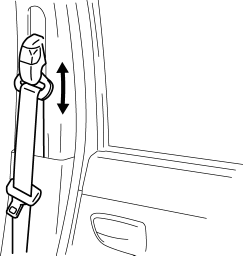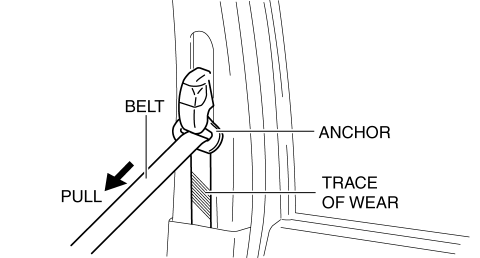Mazda CX-5 Service & Repair Manual: Seat Belt Inspection
Belt
1. Verify that the belt is installed properly with no twists or kinks.
2. Verify that there is no damage to the seat belt and no deformation of the metal fittings.
-
If there is any malfunction, replace the seat belt.
ELR (Emergency Locking Retractor)
Except rear center seat belt
1. Verify that the belt can be pulled out smoothly, and that it retracts smoothly.

-
If there is any malfunction, replace the seat belt.
2. Verify that the retractor locks when the belt is pulled quickly.
-
If there is any malfunction, replace the seat belt.
3. Remove the retractor.
4. While pulling the seat belt out, make sure that the seat belt does not lock when the retractor is tilted slowly up to 15В°
from the mounted position and locks when the retractor is tilted 40В° or more.

-
If there is any malfunction, replace the seat belt.
Rear center seat belt
CAUTION:
-
The rear center seat belt ELR only becomes operable after a certain amount of belt webbing is pulled out. For the ELR inspection, fasten the rear center seat belt to the rear buckle (center) and perform the inspection after pulling out the rear center seat belt 130 mm {5.12 in} (ELR operable condition). If the inspection is performed while the ELR is not in an operable condition, the integrity of the system cannot be determined.
1. Fasten the rear center seat belt to the rear buckle (center) and pull out the rear center seat belt 130 mm {5.12 in}
.

2. Verify that the belt can be pulled out smoothly, and that it retracts smoothly.
-
If there is any malfunction, replace the seat belt.
3. Verify that the retractor locks when the belt is pulled quickly.
-
If there is any malfunction, replace the seat belt.
4. Remove the retractor.
5. While pulling the seat belt out, make sure that the seat belt does not lock when the retractor is tilted slowly up to 15В°
from the mounted position and locks when the retractor is tilted 40В° or more.

-
If there is any malfunction, replace the seat belt.
ALR (Automatic Locking Retractor)
1. Pull the belt out fully to change the lock mode from ELR to ALR.
2. Verify that retractor makes a clicking sound as the belt slowly retracts. If no sound is heard, the lock mode has not changed to ALR. If necessary, repeat Step 1.
-
If there is any malfunction, replace the rear seat belt.
3. Verify that the retractor locks when pulled.
-
If there is any malfunction, replace the rear seat belt.
4. Verify that the lock mode changes to ELR when the belt is fully pulled out.
-
If there is any malfunction, replace the rear seat belt.
Load Limiter Retractor
WARNING:
-
When the load limiter operates, the belt and anchor rub against each other strongly leaving wear tracks. If the seat belt is used in this state, the seat belt will not function at its full capability and there is the possibility of serious injury to passengers. Be sure to replace the seat belt once the load limiter operates.
1. If the vehicle has been subjected to a shock in an accident, pull the belt from the retractor and confirm that there are no wear tracks (the load limiter has not operated) by visually inspecting and feeling the belt.

-
If there is any malfunction, replace the seat belt.
 Seat Belt
Seat Belt
Outline (Standard Deployment Control System)
Three-point front seat belts with the following functions for front seat
passengers adopted.
ELR (Emergency Locking Retractor: emerg ...
 Steering
Steering
...
Other materials:
Rear Seat Center Armrest Removal/Installation
1. Operate the push knob (RH) and lower the rear seat back (RH).
2. Remove screw A.
3. Remove the rear seat center armrest hinge cover (RH) in the direction of the
arrow (1) shown in the figure while setting hook A aside.
4. Remove bolt B.
5. Remove the rear seat center armrest in ...
Oil Control Valve (OCV) Inspection [Skyactiv G 2.0]
Coil Resistance Inspection
1. Disconnect the negative battery cable..
2. Remove the plug hole plate..
3. Disconnect the OCV connector.
4. Measure the resistance between terminals A and B using an ohmmeter.
OCV coil resistance
6.9—7.5 ohms [20°C {68°F}]
If ...
Battery Runs Out
Jump-Starting
Jump-starting is dangerous if done incorrectly. So follow the procedure carefully.
If you feel unsure about jump-starting, we strongly recommend that you have a competent
service technician do the work.
WARNING
Follow These Precautions Carefully:
To ensure safe and correct ...
